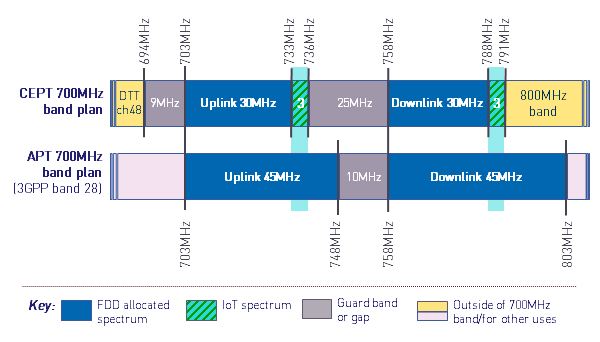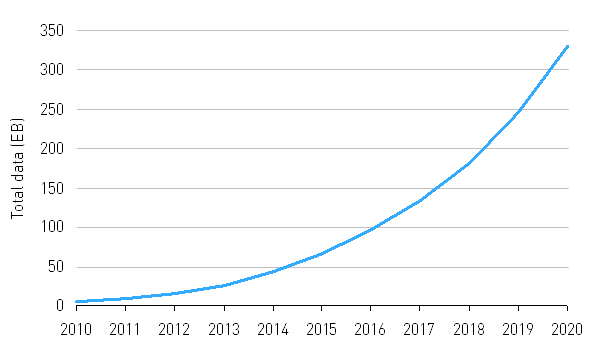Successful deployment of NB-IoT will depend on spectrum choices
30 January 2017 | Regulation and policy
Article| IoT Services| Wireless Infrastructure
Standardisation of “narrowband IoT” (NB-IoT) occurred rapidly during 2016, and major mobile operators such as Deutsche Telekom and Vodafone are planning wide-scale roll-out. This article discusses the spectrum options for NB-IoT and their commercial implications. Noting that there are three options for deployment – namely in-band deployment alongside LTE traffic, ‘guard-band’ deployment at the edges of existing LTE carriers, and use of separately assigned spectrum – the article discusses the trade-offs involved and the factors determining the best deployment choice.
The speed at which the industry has standardised NB-IoT suggests strong demand for the new technology
The rapidly developing Internet of Things (IoT) market is being enabled by various wireless technologies. A recent addition to this already crowded market is narrowband-IoT (NB-IoT). This modified version of the established 4G (LTE) technology uses narrower channels (i.e. 200kHz compared to 10MHz for LTE use).
The fast pace of NB-IoT standardisation during 2016 suggests there is demand for its commercial deployment, to address a wide array of IoT uses over cellular networks. There are similarities between some of these uses and those being associated with Fifth Generation (5G) services. However, NB-IoT provides an immediate solution for mobile operators to create successful IoT businesses well before 5G becomes a commercial reality.
The three deployment options for NB-IoT RANs have performance implications, both for IoT deployment and for MBB
From the perspective of the radio access network (RAN) there are three NB-IoT deployment options.
- Two of these options are suitable for deployment in spectrum that has already been licensed:
- an ‘in-band’ option, where NB-IoT is deployed within existing LTE spectrum used for mobile broadband (MBB) services
- a ‘guard-band’ option using spectrum at the channel edges of existing LTE carriers (where roll-off from spectral emissions creates ‘in-band guard bands’, which can be used without taking capacity from the main LTE traffic carriers)
- The third option is to deploy NB-IoT using a separate assignment of spectrum (i.e. ‘standalone’ deployment), and different LTE frequency carriers from those assigned to mobile operators for MBB use.
To date, regulators have not assigned separate frequencies for NB-IoT, although this approach is available. For example, it would be possible to assign IoT spectrum from the 700MHz band (so-called ‘2×3MHz’, from 733–736MHz and 788–791MHz). This 2×3MHz spectrum is adjacent to the main MBB-focused 700MHz band plan (as shown in Figure 1 below1 )and so would have no impact on the amount of spectrum available for MBB.
Figure 1: 700MHz band plans for Europe and Asia, highlighting the 2×3MHz spectrum assignment suitable for IoT [Source: Analysys Mason, 2017]

There appear to be various advantages of using separately assigned spectrum rather than an in-band deployment. For example, operators could deploy IoT services without taking up spectrum resource and/or affecting the quality of service of MBB services. Similarly, although the guard-band solution uses less MBB capacity than the in-band deployment option, it is unlikely the guard-band solution can offer the same levels of performance as when using separately assigned spectrum, due to more limited prospects for optimising site placement, coverage and capacity for the IoT traffic.
There could also be other benefits from using separate spectrum, including the possibility of optimising RANs to provide superior indoor coverage. There might also be device upsides, such as a reduction in power consumption from having better indoor coverage. Some IoT use cases require high levels of network availability due to the nature of traffic being carried (e.g. applications within the healthcare sector, or connections to/from vehicles). Separately assigned spectrum could provide more reliable connections for these situations, whilst also leveraging existing sites and network assets (e.g. billing and security).
If NB-IoT take-up is strong and MBB capacity demand continues to grow, major operators’ plans for in-band deployment could compromise network performance
Despite the performance compromises noted above, Vodafone’s plans to offer NB-IoT services in markets across Europe involve using its existing 800MHz spectrum. Vodafone has indicated that this is because its 800MHz LTE RAN is ready to support NB-IoT (i.e. most sites can be software upgraded and current systems can be updated quickly without needing extensive additional infrastructure).2 One of the key benefits for Vodafone is likely to be speed to market. However, given the rapid increase in MBB traffic reported recently, and forecasts of continued strong growth (see Figure 2), it could be challenging to support IoT and MBB traffic within the same carriers without compromising network performance.
Figure 2: Forecast growth in worldwide mobile data traffic, excluding IoT [Source: Analysys Mason, 2017]

Vodafone’s spectrum portfolio (including 2.6GHz spectrum and sub-1GHz bands such as 900MHz) might help to reduce any impact on network performance. However, other mobile operators with smaller spectrum holdings may be less able to mitigate this effect.
Industry sources point to key benefits of NB-IoT being quality of service and the possibility of re-using LTE infrastructure (e.g. sites, backhaul and core network capabilities). LTE infrastructure can be re-used whether deploying within existing LTE MBB spectrum or in separately assigned carrier(s). However, quality of service depends on the spectrum being used – the possibility of mobile operators capturing a significant share of IoT traffic is important in this regard, since as traffic levels grow the quality of service for both IoT and MBB will decline (unless separate spectrum is available).
Regulators currently appear unconvinced about the need to assign separate spectrum for IoT
The lack of harmonised spectrum for NB-IoT suggests that regulators are unconvinced about a market need for separately assigned spectrum. If separate spectrum were to be made available several policy questions could arise, such as: How many separate networks can be supported in 2×3MHz? How many networks are required? Are there competition implications for the MBB market?
With no regionally or globally harmonised solution for separately assigned spectrum, it seems likely that early deployments will follow Vodafone’s model of in-band deployment. Ultimately, the success or otherwise of these early launches of NB-IoT using capacity from LTE carriers could determine whether further dedicated spectrum is needed.
1 ECC Decision (15)01 includes the 2×3MHz IoT spectrum as an option; see http://www.erodocdb.dk/doks/doccategoryECC.aspx?doccatid=1
2 See http://www.vodafone.com/content/index/what/technology-blog/enabling-iot.html
Downloads
Article (PDF)Authors


